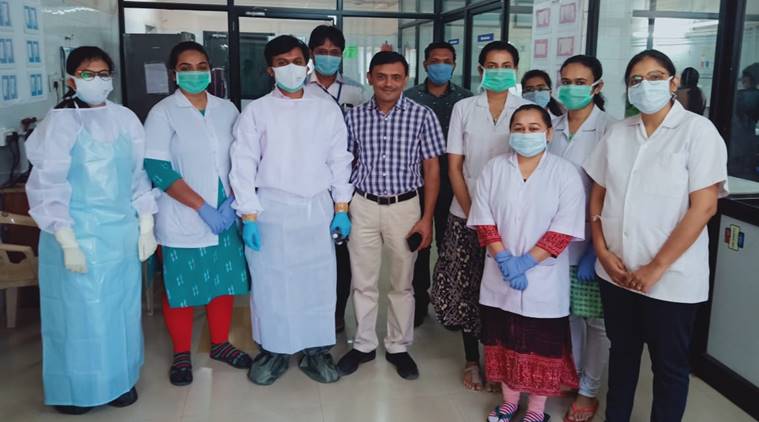 Staff of microbiology laboratory at PDU Medical College in Rajkot. (Express photo)
Staff of microbiology laboratory at PDU Medical College in Rajkot. (Express photo)
AFTER a 10-hour shift at the microbiology laboratory of the PDU Medical College in the city, the 30-something lab technician rides back home on his scooter at 6 pm. He takes a shower on the ground floor of his home before going upstairs where his six-year-old son is eager to embrace him. He hesitates, the memory of the 90 samples of suspected cases of coronavirus he had handled during the day still very fresh in his mind.
The technician works in the First Chamber, the laboratory section housing biosafety cabinet where samples collected by health staff and packed in viral transport media (VTM) tubes are opened, marking the beginning of the testing process.
The father eventually gives in to emotion and embraces the son. His job at the laboratory is, coordination with a junior ‘Can’t afford to take a day off, if we don’t do the tests, who else will?’ resident doctor, to open VTM tubes, potentially containing the virus and extract 200 microlitre from them as sample for testing. Each tube contains about 4000 microlitre of the VTM. After extracting the test sample, the technician helps adds in it a chemical buffer which kills the virus. Eventually, he sends it for second stage where RNA of the virus is extracted onward for PCR. The entire process in first stage takes five minutes, but any lapse can potentially lead to the technician contracting the virus himself.
“Ours is the only chamber in the entire laboratory which deals with live organism and the threat of exposure to the virus is real and high. Therefore, the job demands the highest level of concentration. This in turn, keeps the mind consumed even after leaving the laboratory. Many a time, while resting at home, my mind rewinds vivid imagery of samples I had handled during the day. That imagery sometimes makes me think that I didn’t handle this or that sample well from safety perspective. Such thoughts prompt me to rush back to the bathroom and have another shower,” says the technician who has been working in laboratories for 12 years.
While the team of the technician and a junior resident doctor process the samples in biosafety cabinet, a senior person observes their work to ensure that any lapse or accident doesn’t go unreported and without mitigation measures.
“When Ahmedabad started sending samples here, we were stretched to our limits. We would be in the lab from 6 am to 6 pm, with no fixed lunch break,” the technician says, adding once he puts on a PPE kit, he can’t even have a glass of water for hours as the kits are meant to be used only once. Today the lab tests between 50 and 100 samples in a day, but for two days, when curfew was on it would test up to 200 a day.
 While the team of the technician and a junior resident doctor process the samples in biosafety cabinet, a senior person observes their work to ensure that any lapse or accident doesn’t go unreported and without mitigation measures. (Express photo)
While the team of the technician and a junior resident doctor process the samples in biosafety cabinet, a senior person observes their work to ensure that any lapse or accident doesn’t go unreported and without mitigation measures. (Express photo)
Does he fear contracting the infection? “Not really. I know how to protect myself. But I do remain concerned about my children, one of them just a few weeks old. They might not have developed the immunity yet. I take precautions baaki hari-ichha (the rest is God’s will),” says the technician, who holds a degree in microbiology.
Since the Rajkot laboratory started testing COVID-19 samples from March 28, the technician says he has been avoiding going home for lunch. “We used to eat our tiffins in the college canteen. But of late, lots of people from outside have started visiting the canteen as hotels and eateries are closed. As we work in a sensitive setup, we need to keep our contacts with other people minimal. So, our head, Dr Prakash Modi has allotted us a space in the college building itself where we have our lunch,” he says.
He has not taken a single day off since the COVID-19 tests. “We cannot say no to work these days. We understand we are among a few people who specialise in this job. If we don’t do the tests, who else will?” he says.
Dr Gauravi Dhruva, dean of PDU Medical College, says the college is providing best facilities in the laboratory. “For ensuring the highest level of safety, we replaced the existing biosafety cabinet with a new one. We are ensuring that the lab staff have enough stock of kit material and equipment,” said Dhruva.
Dr Modi, the head of the laboratory says he tries to keep his team motivated. “I remain in constant touch with my team,” he said.